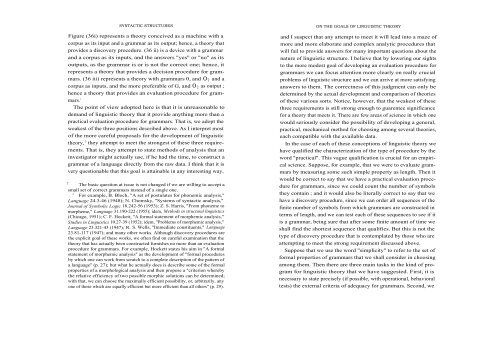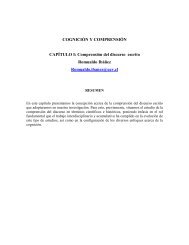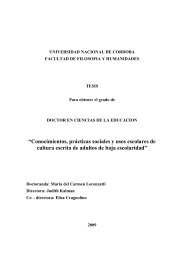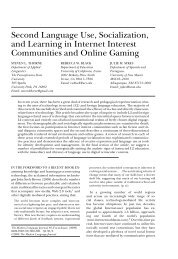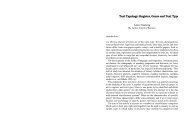Syntactic Structures
Syntactic Structures
Syntactic Structures
Create successful ePaper yourself
Turn your PDF publications into a flip-book with our unique Google optimized e-Paper software.
SYNTACTIC STRUCTURES<br />
Figure (36i) represents a theory conceived as a machine with a<br />
corpus as its input and a grammar as its output; hence, a theory that<br />
provides a discovery procedure. (36 ii) is a device with a grammar<br />
and a corpus as its inputs, and the answers "yes" or "no" as its<br />
outputs, as the grammar is or is not the correct one; hence, it<br />
represents a theory that provides a decision procedure for grammars.<br />
(36 iii) represents a theory with grammars 0, and 0 2 and a<br />
corpus as inputs, and the more preferable of G, and 0 2 as output ;<br />
hence a theory that provides an evaluation procedure for grammars.<br />
2<br />
The point of view adopted here is that it is unreasonable to<br />
demand of linguistic theory that it provide anything more than a<br />
practical evaluation procedure for grammars. That is, we adopt the<br />
weakest of the three positions described above. As I interpret most<br />
of the more careful proposals for the development of linguistic<br />
theory, 3 they attempt to meet the strongest of these three requirements.<br />
That is, they attempt to state methods of analysis that an<br />
investigator might actually use, if he had the time, to construct a<br />
grammar of a language directly from the raw data. I think that it is<br />
very questionable that this goal is attainable in any interesting way,<br />
2<br />
The basic question at issue is not changed if we are willing to accept a<br />
small set of correct grammars instead of a single one.<br />
3 For example, B. Bloch, "A set of postulates for phonemic analysis,"<br />
Language 24.3-46 (1948); N. Chomsky, "Systems of syntactic analysis,"<br />
Journal of Symbolic Logic 18.242-56 (1953); Z. S. Harris, "From phoneme to<br />
morpheme," Language 31.190-222 (1955); idem, Methods in structural linguistics<br />
(Chicago, 1951); C. F. Hockett, "A formal statement of morphemic analysis,"<br />
Studies in Linguistics 10.27-39 (1952); idem, "Problems of morphemic analysis,"<br />
Language 23.321-43 (1947); R. S. Wells, "Immediate constituents," Language<br />
23.81-117 (1947); and many other works. Although discovery procedures are<br />
the explicit goal of these works, we often find on careful examination that the<br />
theory that has actually been constructed furnishes no more than an evaluation<br />
procedure for grammars. For example, Hockett states his aim in "A formal<br />
statement of morphemic analysis" as the development of "formal procedures<br />
by which one can work from scratch to a complete description of the pattern of<br />
a language" (p. 27); but what he actually does is describe some of the formal<br />
properties of a morphological analysis and then propose a "criterion whereby<br />
the relative efficiency of two possible morphic solutions can be determined;<br />
with that, we can choose the maximally efficient possibility, or, arbitrarily, any<br />
one of those which are equally efficient but more efficient than all others" (p. 29).<br />
ON THE GOALS OF LINGUISTIC THEORY<br />
and I suspect that any attempt to meet it will lead into a maze of<br />
more and more elaborate and complex analytic procedures that<br />
will fail to provide answers for many important questions about the<br />
nature of linguistic structure. I believe that by lowering our sights<br />
to the more modest goal of developing an evaluation procedure for<br />
grammars we can focus attention more clearly on really crucial<br />
problems of linguistic structure and we can arrive at more satisfying<br />
answers to them. The correctness of this judgment can only be<br />
determined by the actual development and comparison of theories<br />
of these various sorts. Notice, however, that the weakest of these<br />
three requirements is still strong enough to guarentee significance<br />
for a theory that meets it. There are few areas of science in which one<br />
would seriously consider the possibility of developing a general,<br />
practical, mechanical method for choosing among several theories,<br />
each compatible with the available data.<br />
In the case of each of these conceptions of linguistic theory we<br />
have qualified the characterization of the type of procedure by the<br />
word "practical". This vague qualification is crucial for an empirical<br />
science. Suppose, for example, that we were to evaluate grammars<br />
by measuring some such simple property as length. Then it<br />
would be correct to say that we have a practical evaluation procedure<br />
for grammars, since we could count the number of symbols<br />
they contain ; and it would also be literally correct to say that we<br />
have a discovery procedure, since we can order all sequences of the<br />
finite number of symbols from which grammars are constructed in<br />
terms of length, and we can test each of these sequences to see if it<br />
is a grammar, being sure that after some finite amount of time we<br />
shall find the shortest sequence that qualifies. But this is not the<br />
type of discovery procedure that is contemplated by those who are<br />
attempting to meet the strong requirement discussed above.<br />
Suppose that we use the word "simplicity" to refer to the set of<br />
formal properties of grammars that we shall consider in choosing<br />
among them. Then there are three main tasks in the kind of program<br />
for linguistic theory that we have suggested. First, it is<br />
necessary to state precisely (if possible, with operational, behavioral<br />
tests) the external criteria of adequacy for grammars. Second, we


